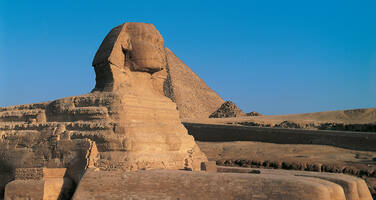Memphis and its Necropolis – the Pyramid Fields from Giza to Dahshur
Factors affecting the property in 1999*
- Ground transport infrastructure
- Impacts of tourism / visitor / recreation
- Land conversion
- Management systems/ management plan
- Other Threats:
Deterioration of the stones
Factors* affecting the property identified in previous reports
- Growing number of visitors
- Uncontrolled development of the nearby village (issue resolved)
- Deterioration of the stones
- Road construction project (issue resolved)
- Encroachment upon the site and its buffer zone
International Assistance: requests for the property until 1999
Total amount approved : 81,450 USD
| 1995 | Experts missions to Pyramids Plateau (Approved) | 13,450 USD |
| 1993 | Financial contribution for the Pyramides Plateau of Giza (Approved) | 20,000 USD |
| 1991 | Three international experts (an economist, an ... (Approved) | 30,000 USD |
| 1991 | Mission to take part in the first stage of the ... (Approved) | 18,000 USD |
Missions to the property until 1999**
Information presented to the Bureau of the World Heritage Committee in 1999
Summary of previous deliberations: The Secretariat reported to the Bureau at its twenty-second extraordinary session that, at the request of the Egyptian authorities, a mission from UNESCO proceeded to Cairo on 3 October 1998 and worked on the Ring-Road issue with the Supreme Council of Antiquities and the concerned ministries. A joint communiqué, signed by the Supreme Council of Antiquities, the Ministry of Housing and Reconstruction and UNESCO urged for a full implementation of the Convention and reconfirmed the alternative route selected during the previous UNESCO mission in 1995 (diversion through the Maryoutiyah and Mansouriyah Canals). The Bureau examined the report and requested the Secretariat to continue co-operating with the Egyptian authorities on the issue of diversion of Ring Road as well as on the overall management of the site and to report on the progress of the work to the Bureau at its twenty-third session. The World Heritage Committee, at its twenty-second session in December 1998, noted the decision of the last Bureau.
New information: In March 1999, in response to the request of the Secretary General of the Supreme Council of Antiquities in Egypt, a monitoring mission visited the site of Memphis and its Necropolis to identify short and long term actions to enhance the integrity, protection and presentation of the site. The mission recommended following: (1) Initiate the Egyptian GIS project by using this World Heritage site (WHS) as the initial model training site to prepare the boundary and base maps necessary for decision-making and management planning; (2) Initiate an integrated interdisciplinary General Management Plan (GMP) training project for the entire WHS including Memphis, and additionally, Abu Rawash; (3) Use the GMP process to address conflict issues and community conditions at Giza and Memphis in particular; (4) Also using the GMP process, develop specific action plans and schedules to address site development, monitoring, maintenance, visitor management and an integrated presentation programme including interpretative themes at appropriate locations distributed in the WHS; (5) Consider the need for expanded on-site laboratory facilities and equipment for emergency conservation and preservation situations (6) The initiation of a site-specific WHS Friends Programme (NGO) and World Heritage Young Peoples Programme adapted for Egypt; (7) Develop a rapid and flexible means to address small scale site management requirements; and, (8) Acknowledge WHS inscription and status with appropriate plaques and information.
The Secretariat supports the above recommendations, in particular items (1) – (4), considering the urgent need to have the GMP for the site.
Action Required
The Bureau, having examined the report of the Secretariat, considers that a general management plan should be established together with a complete mapping of the site. The Bureau recommends to the State Party to study the recommendations of the report and to take actions for the establishment of the integrated interdisciplinary General Management Plan. The Bureau requests the State Party to submit a progress report on the actions taken by 15 September 1999 for examination by the Bureau at its twenty-third extraordinary session.
Summary of the interventions
Decisions adopted by the Committee in 1999
23 BUR IV.B.56
Memphis and its Necropolis – the Pyramid Fields from Giza to Dahshur (Arab Republic of Egypt)
After having examined the report of the Secretariat, the Bureau considered that a General Management Plan should be established with a complete mapping of the site. The Bureau recommended to the State party to study the recommendations of the mission report of March 1999 and to take actions for the establishment of an integrated interdisciplinary General Management Plan. The Bureau requested the State party to submit a progress report on the actions taken by 15 September 1999 for examination by the Committee at its twenty-third session.
* :
The threats indicated are listed in alphabetical order; their order does not constitute a classification according to the importance of their impact on the property.
Furthermore, they are presented irrespective of the type of threat faced by the property, i.e. with specific and proven imminent danger (“ascertained danger”) or with threats which could have deleterious effects on the property’s Outstanding Universal Value (“potential danger”).
** : All mission reports are not always available electronically.


